人教版七年级下册unit 10 Section A Grammar-3c(共24张PPT)
文档属性
| 名称 | 人教版七年级下册unit 10 Section A Grammar-3c(共24张PPT) |  | |
| 格式 | pptx | ||
| 文件大小 | 24.0MB | ||
| 资源类型 | 教案 | ||
| 版本资源 | 人教新目标(Go for it)版 | ||
| 科目 | 英语 | ||
| 更新时间 | 2023-05-23 15:41:07 | ||
图片预览

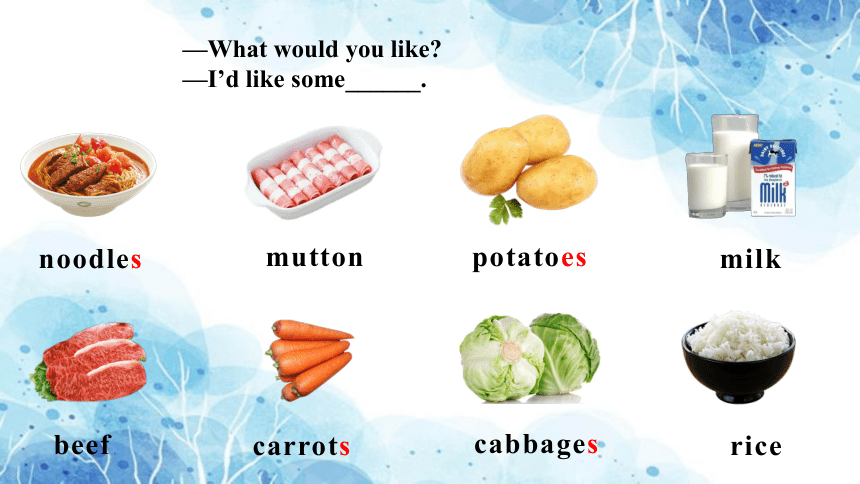
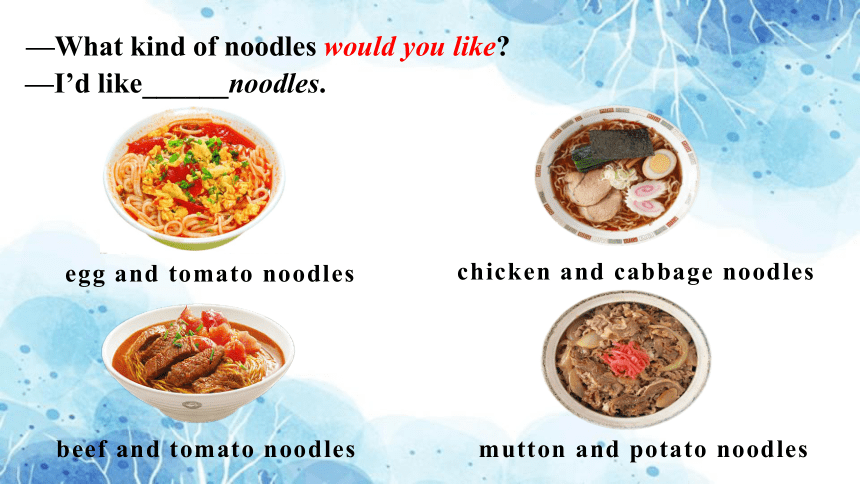
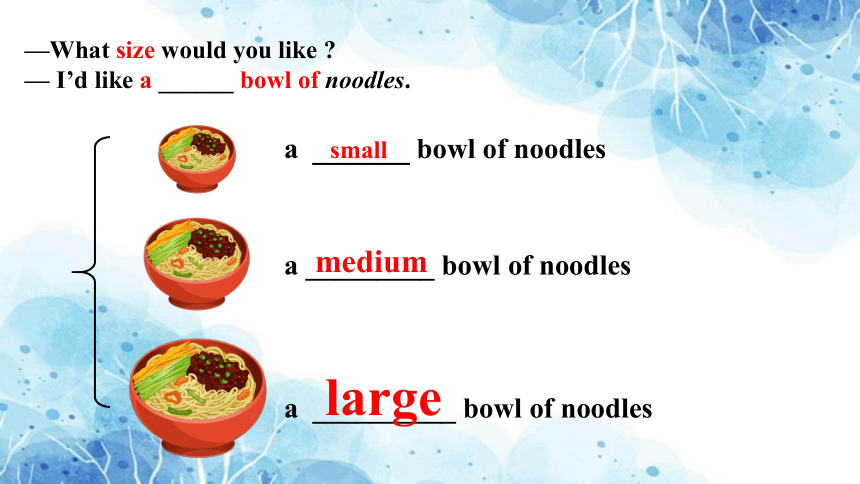
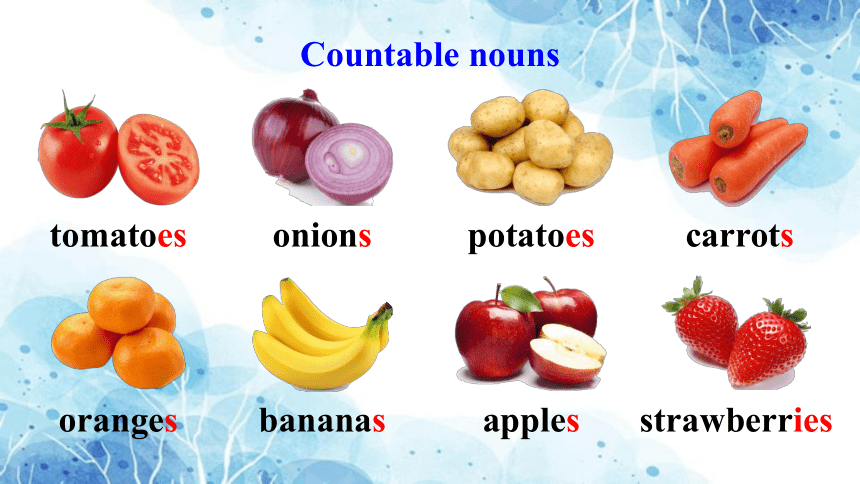
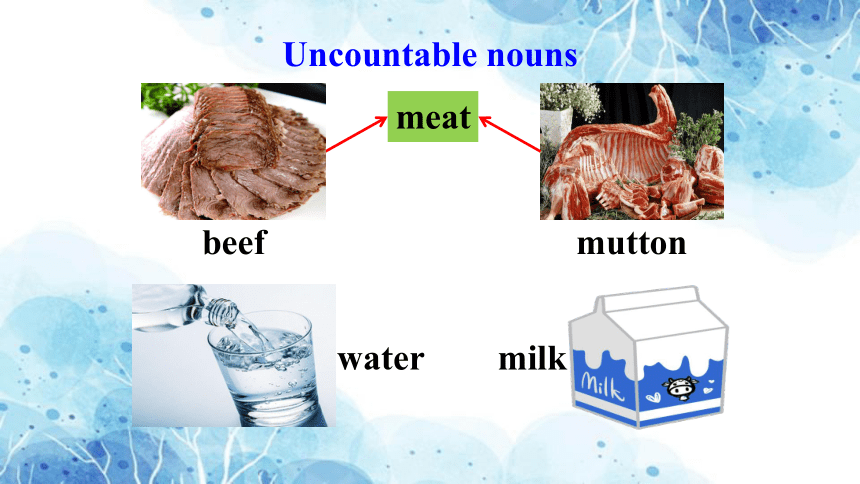
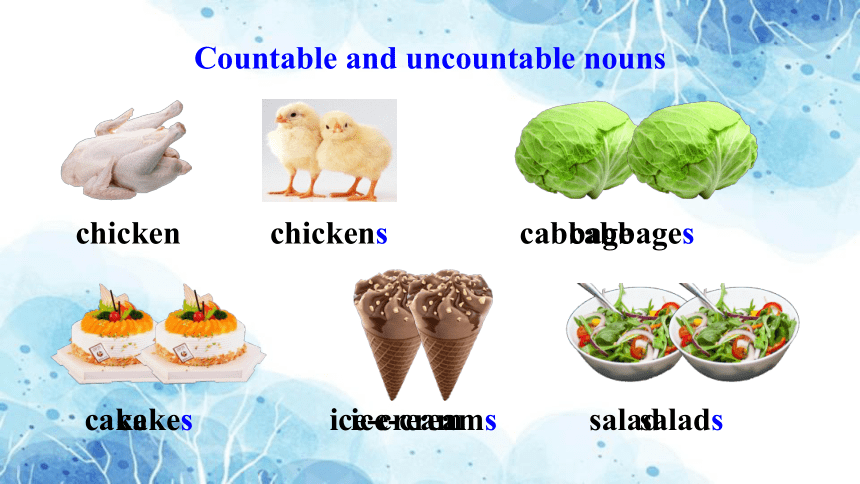
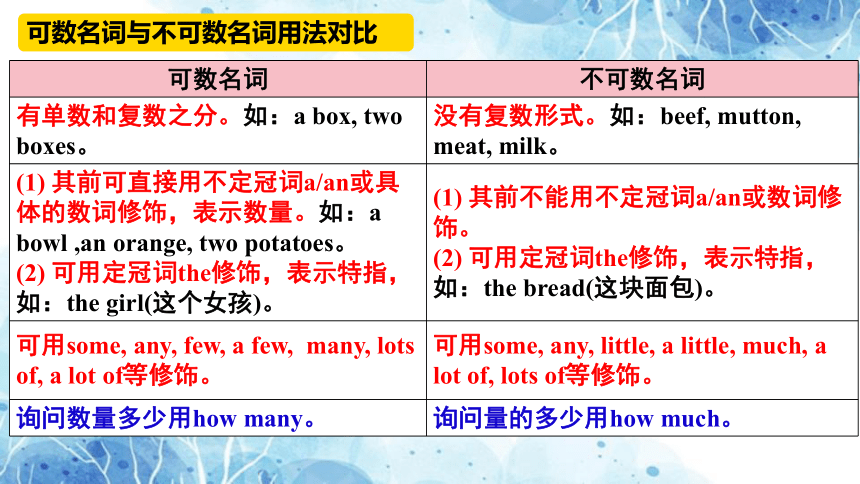
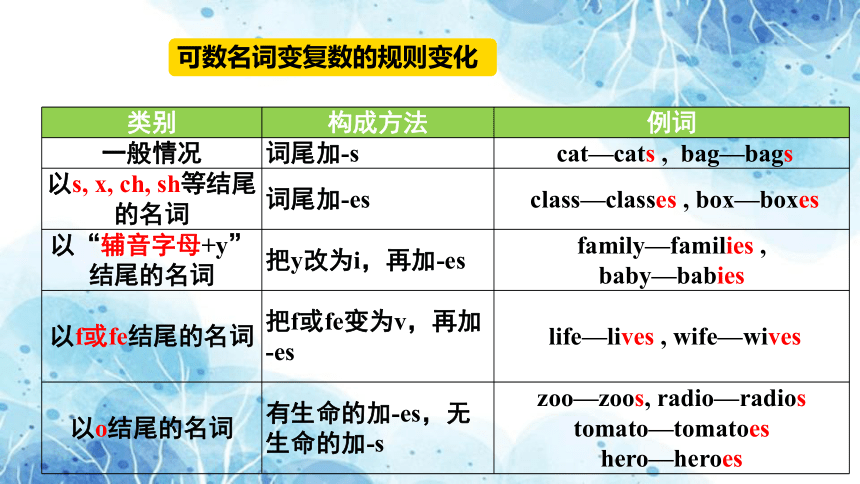
文档简介
(共24张PPT)
Unit 10 I’d like some noodles.
Section A (GF-3c)
Review
—What would you like
—I’d like some______.
carrots
noodles
mutton
potatoes
beef
cabbages
rice
milk
—What kind of noodles would you like
—I’d like______noodles.
egg and tomato noodles
beef and tomato noodles
chicken and cabbage noodles
mutton and potato noodles
Review
—What size would you like
— I’d like a ______ bowl of noodles.
a __________ bowl of noodles
a _________ bowl of noodles
a ______ bowl of noodles
small
medium
large
tomatoes
potatoes
onions
carrots
oranges
apples
bananas
strawberries
Countable nouns
Uncountable nouns
beef
mutton
meat
water
milk
chicken
Countable and uncountable nouns
chickens
cabbage
cabbages
cake
cakes
ice-cream
ice-creams
salad
salads
可数名词与不可数名词用法对比
可数名词 不可数名词
有单数和复数之分。如:a box, two boxes。 没有复数形式。如:beef, mutton, meat, milk。
(1) 其前可直接用不定冠词a/an或具体的数词修饰,表示数量。如:a bowl ,an orange, two potatoes。 (2) 可用定冠词the修饰,表示特指,如:the girl(这个女孩)。 (1) 其前不能用不定冠词a/an或数词修饰。
(2) 可用定冠词the修饰,表示特指,如:the bread(这块面包)。
可用some, any, few, a few, many, lots of, a lot of等修饰。 可用some, any, little, a little, much, a lot of, lots of等修饰。
询问数量多少用how many。 询问量的多少用how much。
类别 构成方法 例词
一般情况 词尾加-s cat—cats , bag—bags
以s, x, ch, sh等结尾的名词 词尾加-es class—classes , box—boxes
以“辅音字母+y”结尾的名词 把y改为i,再加-es family—families ,
baby—babies
以f或fe结尾的名词 把f或fe变为v,再加-es life—lives , wife—wives
以o结尾的名词 有生命的加-es,无生命的加-s zoo—zoos, radio—radios
tomato—tomatoes
hero—heroes
可数名词变复数的规则变化
针对训练
1. Kate likes ______ , but she doesn’t like __________ salad.
A. potato; potato; B. potatoes; potatoes
C. potatoes; potato D. potato; potatoes
2. — Can I help you, Madam
— Yes, I’d like some _____________.
A. pear B. banana C. milks D. tomatoes
3. I’d like some __________ and ___________.
A. banana; tomato B. bananas; tomato
C. bananas; tomatoes D. banana; tomatoes
4. Would you like ______ orange juice, Sir
A. many B. some C. any D. a little
不可数名词量的表达
不可数名词的量可以用 “a/an/基数词+表示量的名词(类似语文量词) + of + 不可数名词” 表示,这些表示量的名词有单复数形式的变化。这一结构作主语时,谓语动词的单复数形式要与表示量的名词保持一致。常见的量词有:piece(条、块、片、张、份、则);glass(玻璃杯) ; cup(茶杯) ; bottle(瓶);basket(篮)、bag(袋)、box(箱,盒)等。
eg:a piece of paper 一张纸 three pieces of paper 三张纸
a piece of meat 一块肉 a piece of bread 一片面包
a glass of milk 一杯牛奶 a cup of tea 一杯茶
six bottles of water 六瓶水 a basket of food 一篮食物
a bag of rice 一袋大米 a box of juice 一箱果汁
There is a bottle of juice on the table. (谓语动词is与a bottle保持一致)
There are three bowls of mutton soup on the table. (谓语动词are与three bowls保持一致)
可数名词与不可数名词用法对比
可数名词 不可数名词
有单数和复数之分。如:a box, two boxes。 没有复数形式。如:beef, mutton, meat, milk。
(1) 其前可直接用不定冠词a/an或具体的数词修饰,表示数量。如:a bowl ,an orange, two potatoes。 (2) 可用定冠词the修饰,表示特指,如:the girl(这个女孩)。 (1) 其前不能用不定冠词a/an或数词修饰。
(2) 可用定冠词the修饰,表示特指,如:the bread(这块面包)。
可用some, any, few, a few, many, lots of, a lot of等修饰。 可用some, any, little, a little, much, a lot of, lots of等修饰。
询问数量多少用how many。 询问量的多少用how much。
What kind of noodles would you like I'd like beef noodles, please.
What size would you like I'd like a large bowl, please.
Would you like a large bowl Yes, please.
Is there any meat in the tomato and egg soup No, there isn't any. /
No, there's no meat.
Grammar Focus
I’d = I would
She’d =She would
您想要哪种面条?
我想要牛肉面。
您想要多大碗的?
我想要一份大碗的。
您想要一份大碗的吗?
是的,请(来一份)。
西红柿鸡蛋汤里有肉吗?
不,没有。/ 不,没有肉。
Would like 意为“想要”。常用句型有:
(1) would like sth. 想要某物:I would like an apple.
(2) would like to do sth. 想要做某事:He’d like to go home.
(3) would like sb. to do sth. 想要某人做某事:
John would like me to go with him.
(4) would是情态动词,变疑问句时将其提前到主语前:
He would like some eggs.
Would he like any eggs
Would like 的用法
1.I’d like a medium bowl. (改为一般疑问句)
________ you ______ a medium bowl
2.They’d like noodles with beef in them. (对画线部分提问)
________ ________ ________ noodles ________ they like
3.I want to buy a new coat. (改为同义句)
I ________ ________ _____ _____a new coat.
4.There are some books in my bag. (改为一般疑问句并作否定回答)
—_____ ______ _____books in your bag
—No, _____ ______ _____.
Would like
What kind of would
would like to buy
Are there any
there aren’t any
按要求完成句子(每空一词)。
Practice
1. some / any通常用在什么句式中?表达什么含义?
2. some /any通常可以用来修饰或限定什么词?
some / any通常接可数名词复数和不可数名词,表示
不确定的数量。
some常译作“一些”,多用于肯定句,也用在疑问
句中,表示期待对方肯定的答复,以示礼貌。
any表示“任何”,通常用于否定句和疑问句中。
用some和any填空。
Practice
1. There isn’t _______ milk in the fridge.
2. I can see _______ cars, but I can’t see _______ buses.
3. He has _______ friends in England.
4. Do you want to take _______ photos
5. Is there _______ rice in the kitchen
6. Can I have _______ milk
some
any
any
some
any
any
some
Complete the conversation below.
3a
a. What kind of noodles do you have
b. Oh, a medium bowl, please.
c. OK, I’d like the mutton noodles then.
d. I’d like some noodles, please.
e. What sizes do you have
f. Are there any vegetables in the mutton noodles
May I have your order _____
2. What kind of noodles would you like _____
3. We have beef, chicken, mutton, cabbage, potato, tomato … _____
4. Yes, there are some carrots. _____
5. Sure. What size would you like _____
6. We have large, medium and small bowls. _____
b
d
a
f
c
e
Write questions and answers using the words in brackets.
3b
1. What kind of noodles would you like (kind)
____________________________________
____________________________________
(chicken / beef / tomatoes)
I’d like chicken and beef noodles with tomatoes.
2. _________________________________ (size)
_________________________________ (medium)
3. _______________________________________
(any/cabbage/beef noodles)
____________________ (no)
What size would you like
I’d like a medium bowl , please.
Is there any cabbage in the beef noodles
No, there isn’t any.
Work in small groups. Who would like the food below Write their names on the cards above the food.
3c
hamburger
potato salad
tomato and egg rice
beef and
carrot noodles
A: Anna, what would you like to eat
B: I’d like beef noodles with carrots.
A: Bill, what would you like to eat
C: I’d like…
Group work
Unit 10 I’d like some noodles.
Section A (GF-3c)
Review
—What would you like
—I’d like some______.
carrots
noodles
mutton
potatoes
beef
cabbages
rice
milk
—What kind of noodles would you like
—I’d like______noodles.
egg and tomato noodles
beef and tomato noodles
chicken and cabbage noodles
mutton and potato noodles
Review
—What size would you like
— I’d like a ______ bowl of noodles.
a __________ bowl of noodles
a _________ bowl of noodles
a ______ bowl of noodles
small
medium
large
tomatoes
potatoes
onions
carrots
oranges
apples
bananas
strawberries
Countable nouns
Uncountable nouns
beef
mutton
meat
water
milk
chicken
Countable and uncountable nouns
chickens
cabbage
cabbages
cake
cakes
ice-cream
ice-creams
salad
salads
可数名词与不可数名词用法对比
可数名词 不可数名词
有单数和复数之分。如:a box, two boxes。 没有复数形式。如:beef, mutton, meat, milk。
(1) 其前可直接用不定冠词a/an或具体的数词修饰,表示数量。如:a bowl ,an orange, two potatoes。 (2) 可用定冠词the修饰,表示特指,如:the girl(这个女孩)。 (1) 其前不能用不定冠词a/an或数词修饰。
(2) 可用定冠词the修饰,表示特指,如:the bread(这块面包)。
可用some, any, few, a few, many, lots of, a lot of等修饰。 可用some, any, little, a little, much, a lot of, lots of等修饰。
询问数量多少用how many。 询问量的多少用how much。
类别 构成方法 例词
一般情况 词尾加-s cat—cats , bag—bags
以s, x, ch, sh等结尾的名词 词尾加-es class—classes , box—boxes
以“辅音字母+y”结尾的名词 把y改为i,再加-es family—families ,
baby—babies
以f或fe结尾的名词 把f或fe变为v,再加-es life—lives , wife—wives
以o结尾的名词 有生命的加-es,无生命的加-s zoo—zoos, radio—radios
tomato—tomatoes
hero—heroes
可数名词变复数的规则变化
针对训练
1. Kate likes ______ , but she doesn’t like __________ salad.
A. potato; potato; B. potatoes; potatoes
C. potatoes; potato D. potato; potatoes
2. — Can I help you, Madam
— Yes, I’d like some _____________.
A. pear B. banana C. milks D. tomatoes
3. I’d like some __________ and ___________.
A. banana; tomato B. bananas; tomato
C. bananas; tomatoes D. banana; tomatoes
4. Would you like ______ orange juice, Sir
A. many B. some C. any D. a little
不可数名词量的表达
不可数名词的量可以用 “a/an/基数词+表示量的名词(类似语文量词) + of + 不可数名词” 表示,这些表示量的名词有单复数形式的变化。这一结构作主语时,谓语动词的单复数形式要与表示量的名词保持一致。常见的量词有:piece(条、块、片、张、份、则);glass(玻璃杯) ; cup(茶杯) ; bottle(瓶);basket(篮)、bag(袋)、box(箱,盒)等。
eg:a piece of paper 一张纸 three pieces of paper 三张纸
a piece of meat 一块肉 a piece of bread 一片面包
a glass of milk 一杯牛奶 a cup of tea 一杯茶
six bottles of water 六瓶水 a basket of food 一篮食物
a bag of rice 一袋大米 a box of juice 一箱果汁
There is a bottle of juice on the table. (谓语动词is与a bottle保持一致)
There are three bowls of mutton soup on the table. (谓语动词are与three bowls保持一致)
可数名词与不可数名词用法对比
可数名词 不可数名词
有单数和复数之分。如:a box, two boxes。 没有复数形式。如:beef, mutton, meat, milk。
(1) 其前可直接用不定冠词a/an或具体的数词修饰,表示数量。如:a bowl ,an orange, two potatoes。 (2) 可用定冠词the修饰,表示特指,如:the girl(这个女孩)。 (1) 其前不能用不定冠词a/an或数词修饰。
(2) 可用定冠词the修饰,表示特指,如:the bread(这块面包)。
可用some, any, few, a few, many, lots of, a lot of等修饰。 可用some, any, little, a little, much, a lot of, lots of等修饰。
询问数量多少用how many。 询问量的多少用how much。
What kind of noodles would you like I'd like beef noodles, please.
What size would you like I'd like a large bowl, please.
Would you like a large bowl Yes, please.
Is there any meat in the tomato and egg soup No, there isn't any. /
No, there's no meat.
Grammar Focus
I’d = I would
She’d =She would
您想要哪种面条?
我想要牛肉面。
您想要多大碗的?
我想要一份大碗的。
您想要一份大碗的吗?
是的,请(来一份)。
西红柿鸡蛋汤里有肉吗?
不,没有。/ 不,没有肉。
Would like 意为“想要”。常用句型有:
(1) would like sth. 想要某物:I would like an apple.
(2) would like to do sth. 想要做某事:He’d like to go home.
(3) would like sb. to do sth. 想要某人做某事:
John would like me to go with him.
(4) would是情态动词,变疑问句时将其提前到主语前:
He would like some eggs.
Would he like any eggs
Would like 的用法
1.I’d like a medium bowl. (改为一般疑问句)
________ you ______ a medium bowl
2.They’d like noodles with beef in them. (对画线部分提问)
________ ________ ________ noodles ________ they like
3.I want to buy a new coat. (改为同义句)
I ________ ________ _____ _____a new coat.
4.There are some books in my bag. (改为一般疑问句并作否定回答)
—_____ ______ _____books in your bag
—No, _____ ______ _____.
Would like
What kind of would
would like to buy
Are there any
there aren’t any
按要求完成句子(每空一词)。
Practice
1. some / any通常用在什么句式中?表达什么含义?
2. some /any通常可以用来修饰或限定什么词?
some / any通常接可数名词复数和不可数名词,表示
不确定的数量。
some常译作“一些”,多用于肯定句,也用在疑问
句中,表示期待对方肯定的答复,以示礼貌。
any表示“任何”,通常用于否定句和疑问句中。
用some和any填空。
Practice
1. There isn’t _______ milk in the fridge.
2. I can see _______ cars, but I can’t see _______ buses.
3. He has _______ friends in England.
4. Do you want to take _______ photos
5. Is there _______ rice in the kitchen
6. Can I have _______ milk
some
any
any
some
any
any
some
Complete the conversation below.
3a
a. What kind of noodles do you have
b. Oh, a medium bowl, please.
c. OK, I’d like the mutton noodles then.
d. I’d like some noodles, please.
e. What sizes do you have
f. Are there any vegetables in the mutton noodles
May I have your order _____
2. What kind of noodles would you like _____
3. We have beef, chicken, mutton, cabbage, potato, tomato … _____
4. Yes, there are some carrots. _____
5. Sure. What size would you like _____
6. We have large, medium and small bowls. _____
b
d
a
f
c
e
Write questions and answers using the words in brackets.
3b
1. What kind of noodles would you like (kind)
____________________________________
____________________________________
(chicken / beef / tomatoes)
I’d like chicken and beef noodles with tomatoes.
2. _________________________________ (size)
_________________________________ (medium)
3. _______________________________________
(any/cabbage/beef noodles)
____________________ (no)
What size would you like
I’d like a medium bowl , please.
Is there any cabbage in the beef noodles
No, there isn’t any.
Work in small groups. Who would like the food below Write their names on the cards above the food.
3c
hamburger
potato salad
tomato and egg rice
beef and
carrot noodles
A: Anna, what would you like to eat
B: I’d like beef noodles with carrots.
A: Bill, what would you like to eat
C: I’d like…
Group work
同课章节目录
- Unit 1 Can you play the guitar?
- Section A
- Section B
- Unit 2 What time do you go to school?
- Section A
- Section B
- Unit 3 How do you get to school?
- Section A
- Section B
- Unit 4 Don't eat in class.
- Section A
- Section B
- Unit 5 Why do you like pandas?
- Section A
- Section B
- Unit 6 I'm watching TV.
- Section A
- Section B
- Review of Units 1-6
- Unit 7 It's raining!
- Section A
- Section B
- Unit 8 Is there a post office near here?
- Section A
- Section B
- Unit 9 What does he look like?
- Section A
- Section B
- Unit 10 I'd like some noodles.
- Section A
- Section B
- Unit 11 How was your school trip?
- Section A
- Section B
- Unit 12 What did you do last weekend?
- Section A
- Section B
